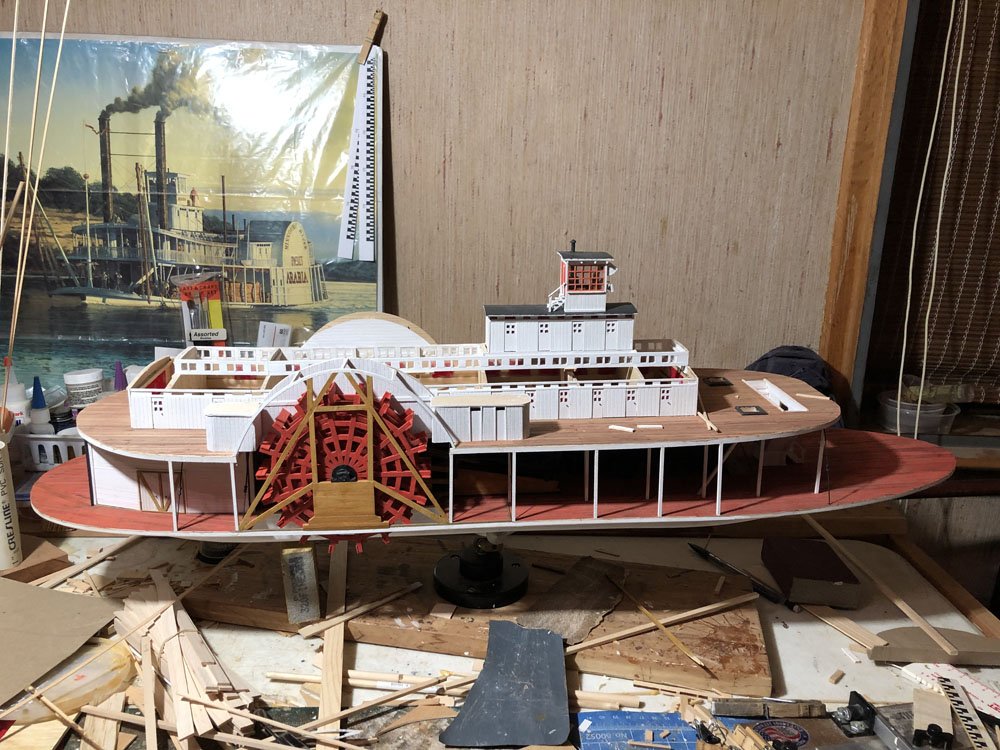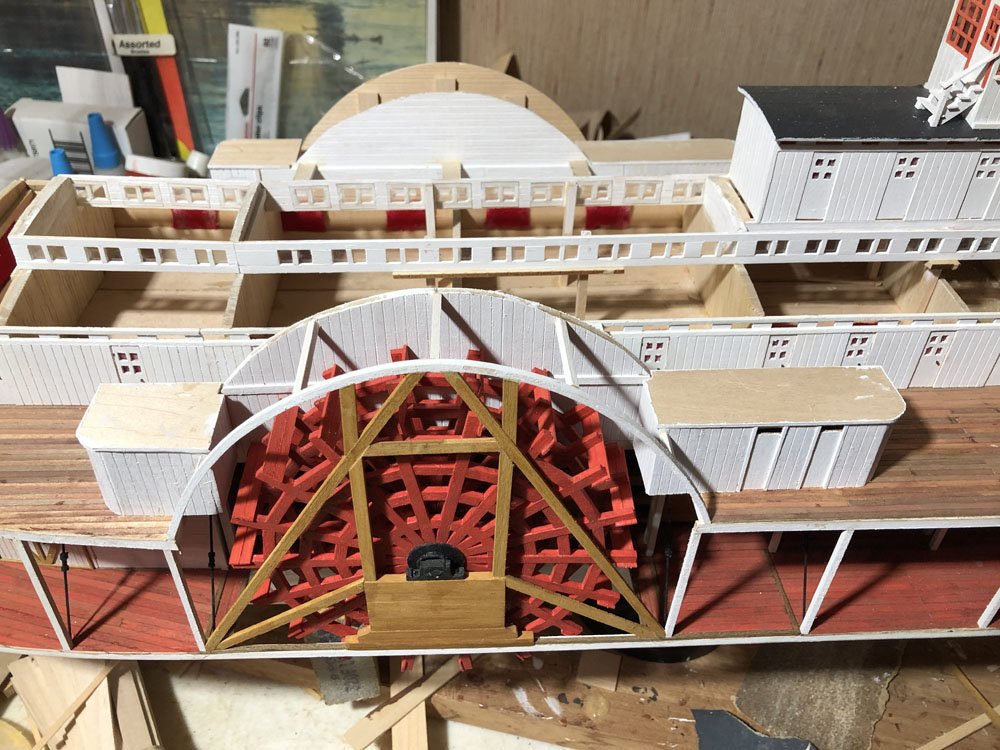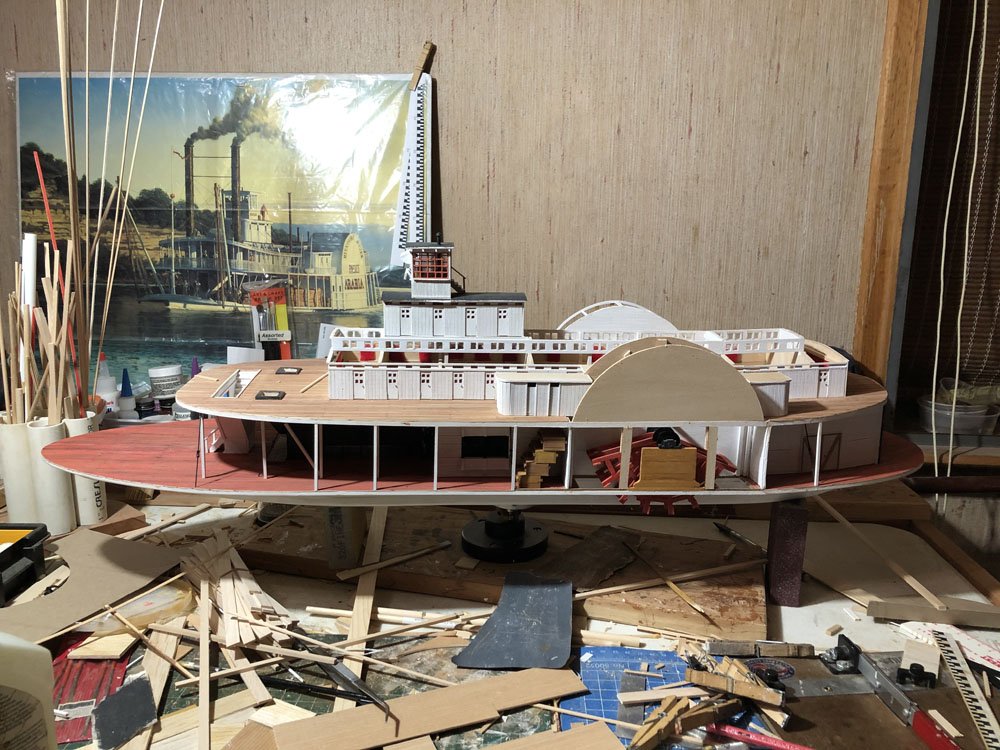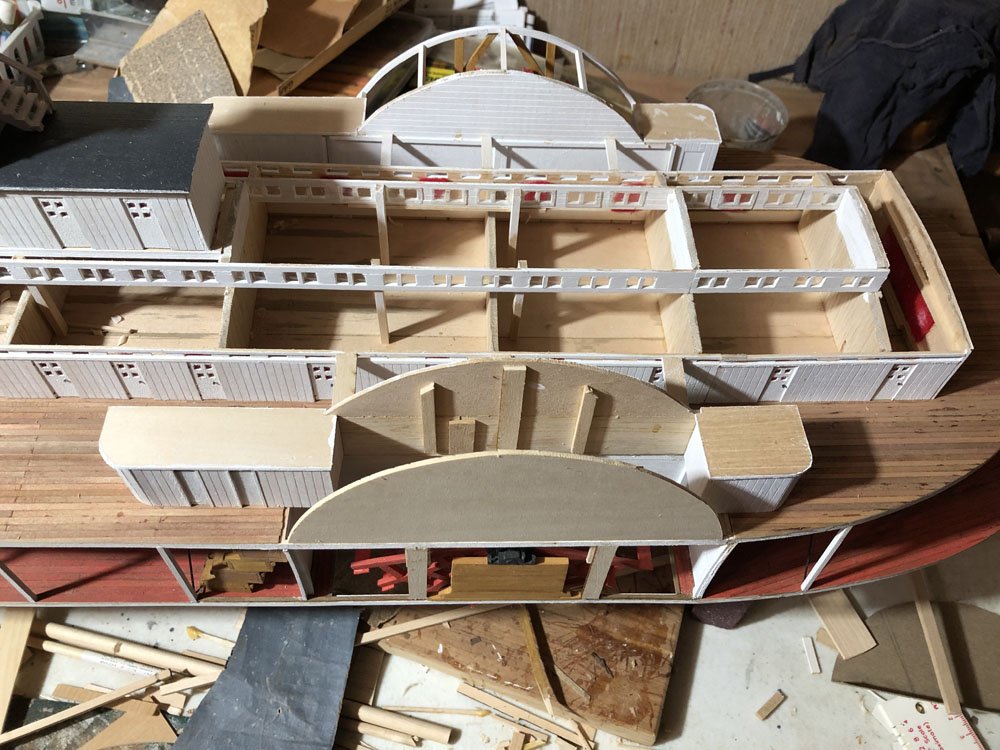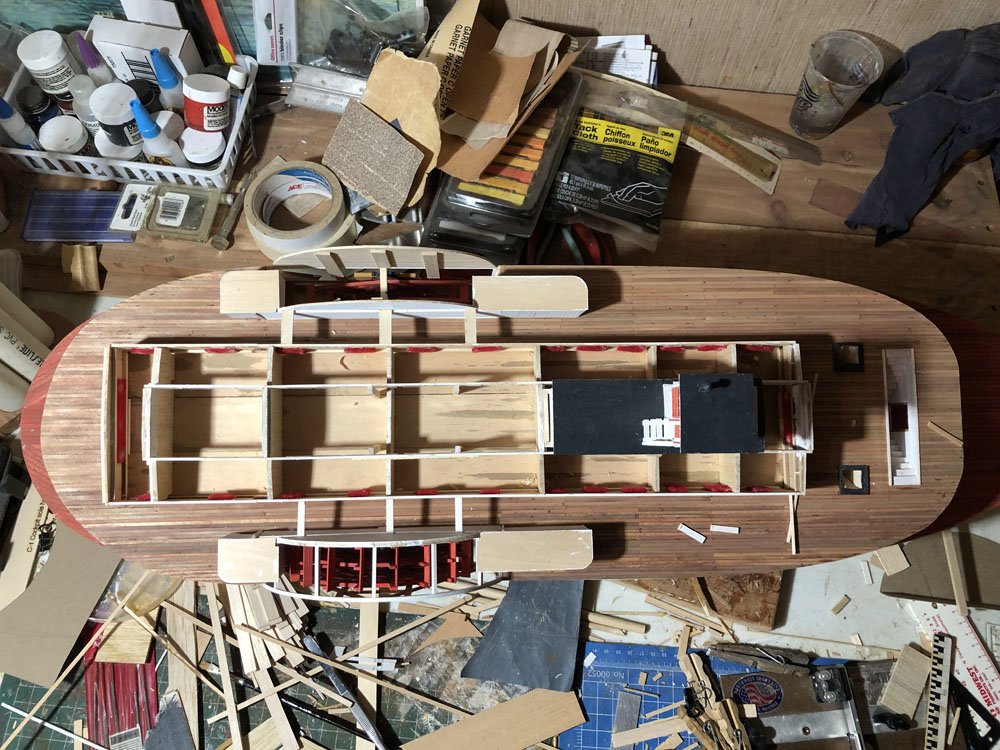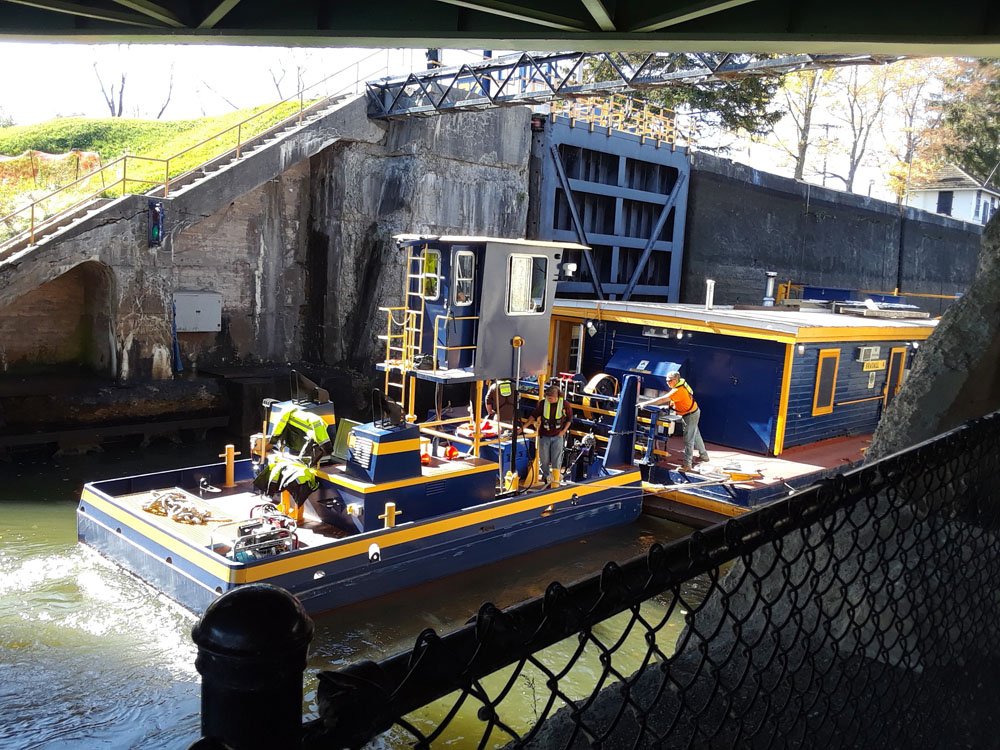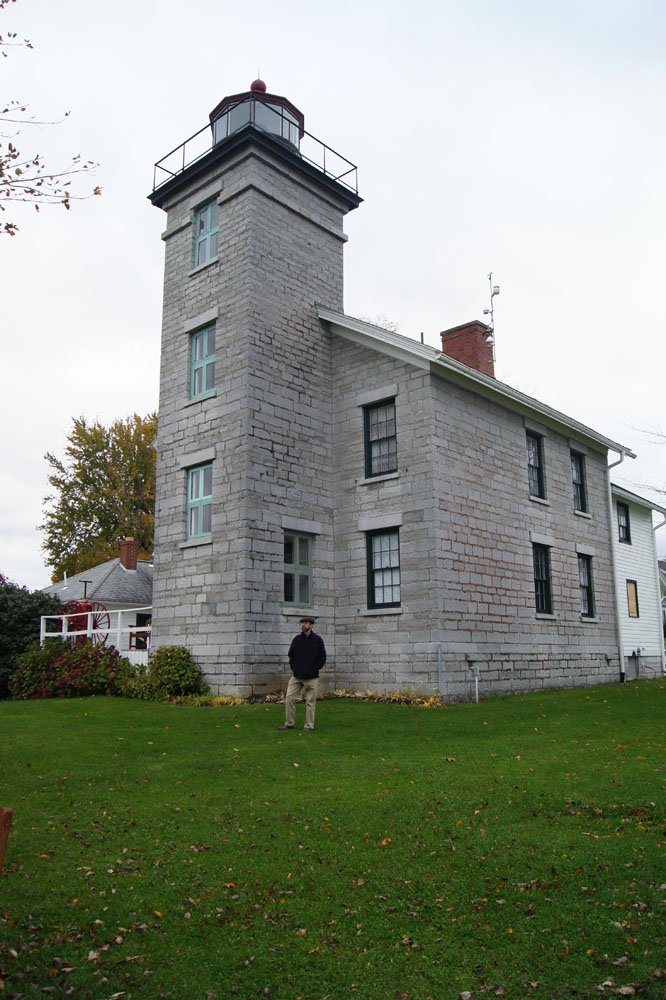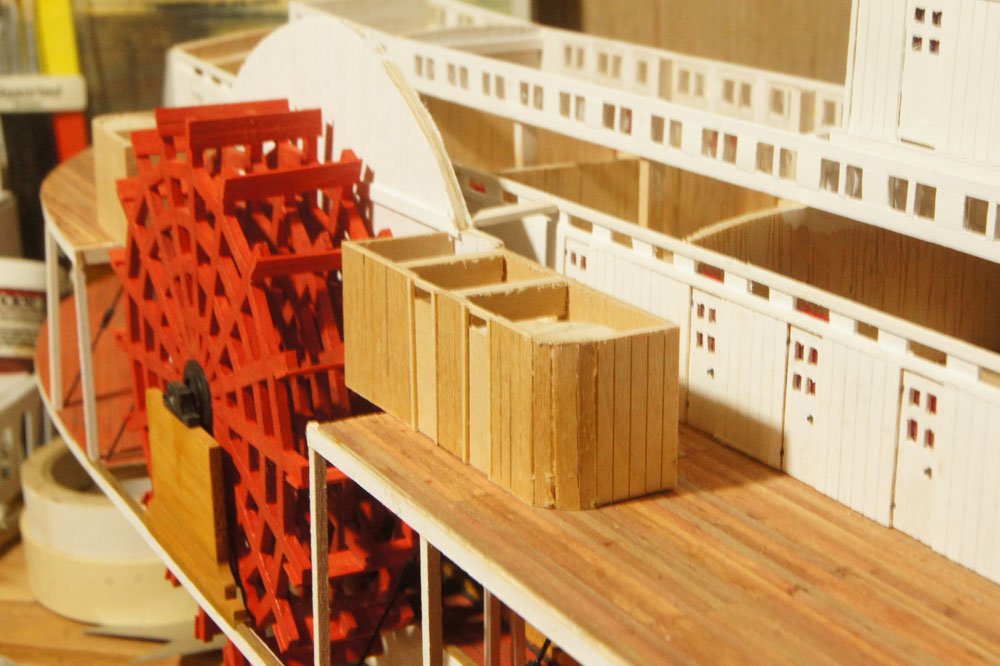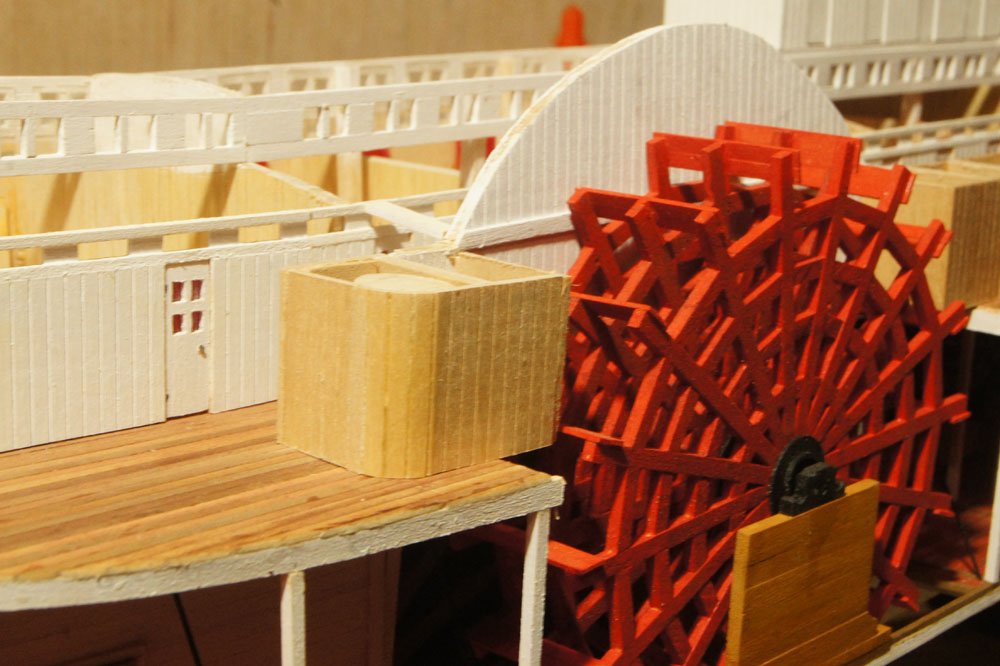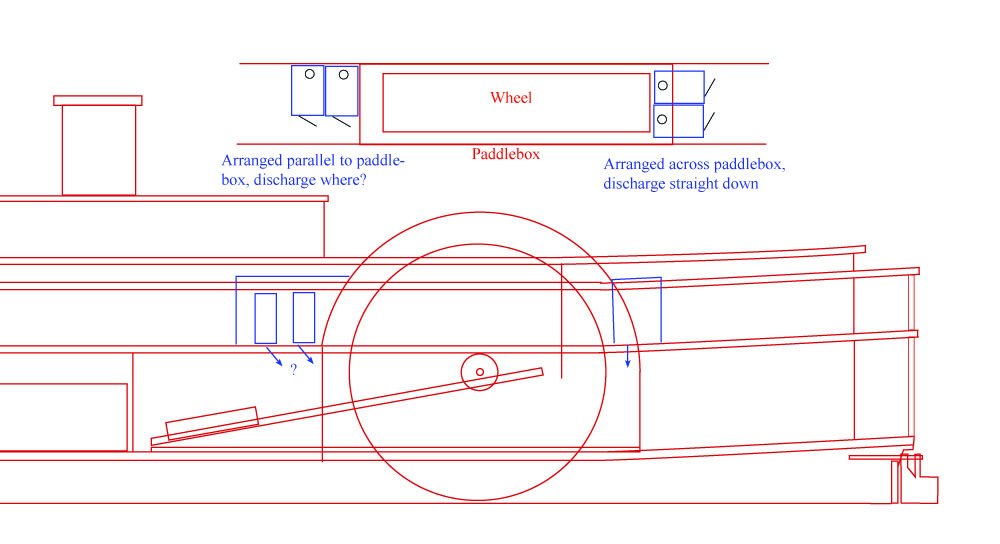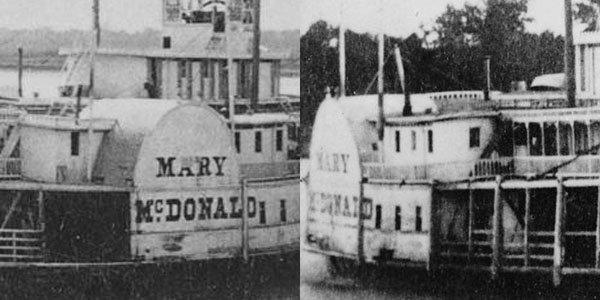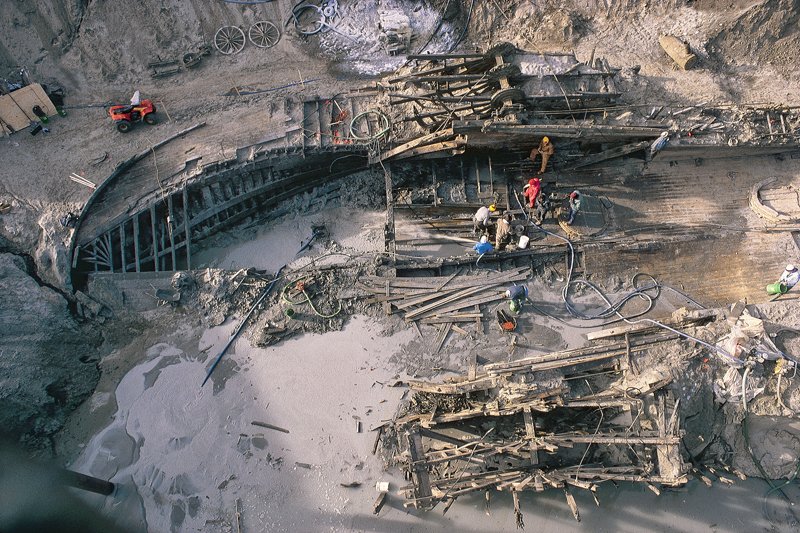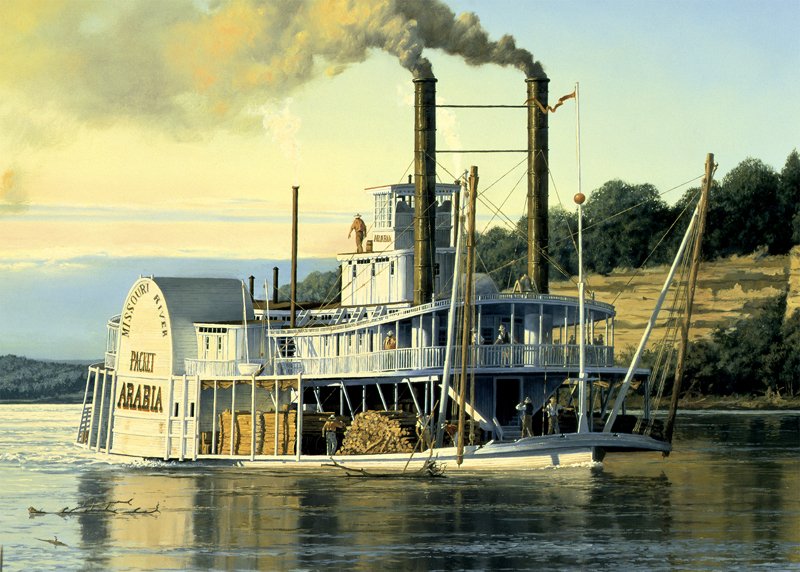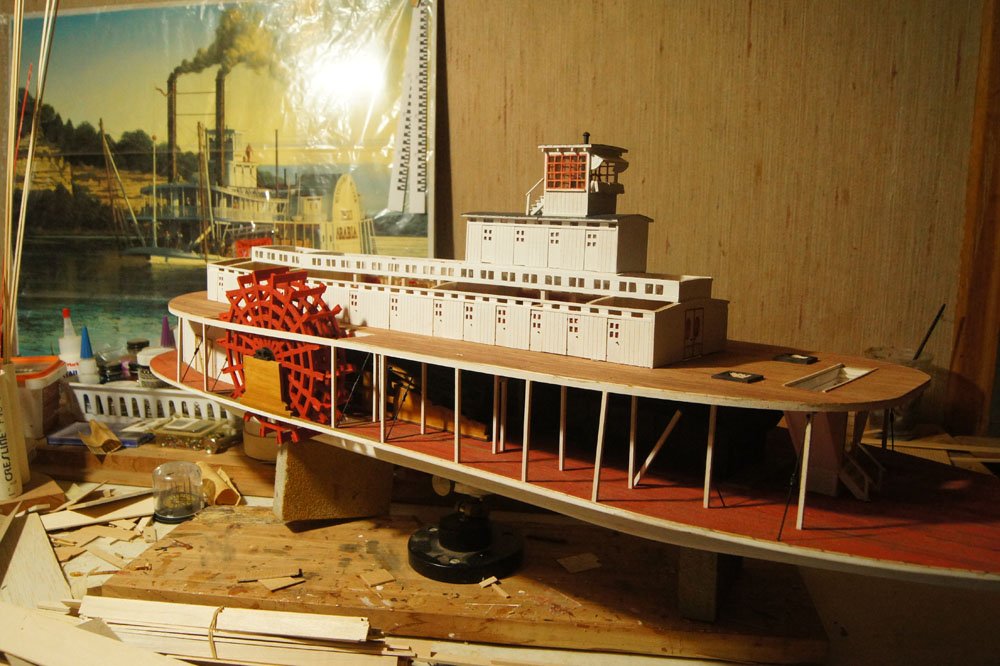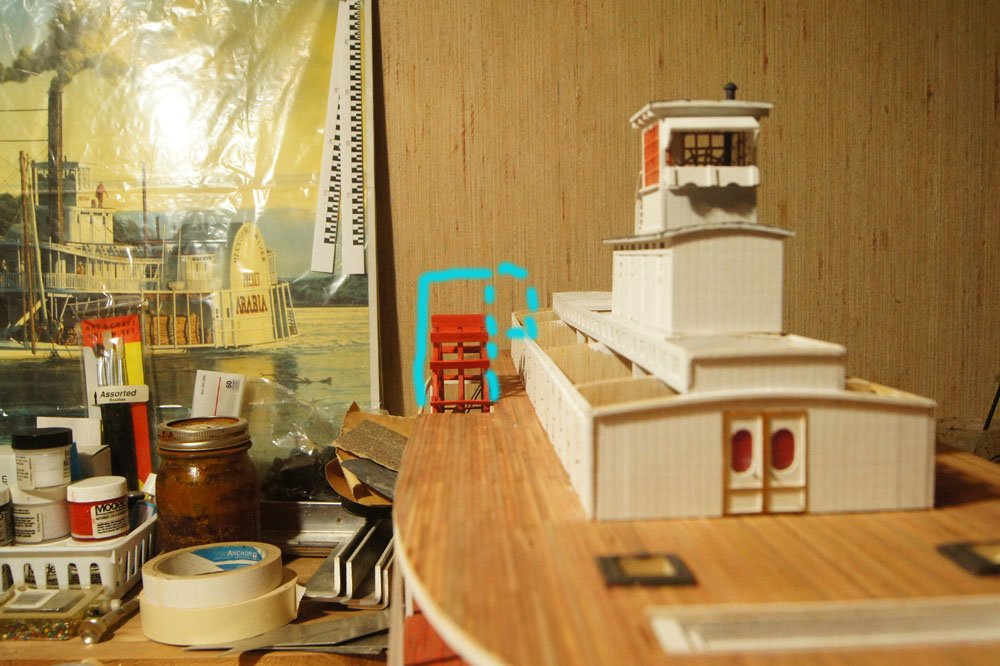-
Posts
3,524 -
Joined
-
Last visited
Content Type
Profiles
Forums
Gallery
Events
Everything posted by Cathead
-

Can i live without a BYRNES TABLE SAW
Cathead replied to shihawk's topic in Modeling tools and Workshop Equipment
Kurt, can you clarify what you mean? The only $30 option is listed as "extended rip fence" but doesn't say anything about being adjustable whereas the "miter gage adjustable extension" is $12. Cog, can you clarify whether/why I would need the micrometer stop? Doesn't the saw already have markings to allow one to set cutting width? I should probably clarify a few other factors for me. I've been doing timber management on my land for over a decade, cutting my own lumber and custom-milling planks and beams for both my own use (sheds, barns, furniture) and sale (other peoples' projects including decks, sheds, garden beds, etc.). So the wood I'd like to use for model work is either already bandsaw-milled into planks or billets and stacked, stickered, and cured, or has the ability to become so. I am not a full-time model maker and do not want to go berserk ordering high-end equipment that will get used a few times a year. It seems to me, and please correct me if I'm wrong, that a basic table saw and tabletop bandsaw (which I already have) should be sufficient for an amateur modeler who wants to occasionally reduce some wild-harvested wood to reasonable billets for the Byrnes saw. I don't care about kerf loss because wood is utterly renewable for me and I have a fleet's worth of it already waiting for use. What I want to do is take rough-cut billets and make model-scale planks or beams in various thickness/width combinations from 1/32" to 1/4", with occasional larger pieces. My understanding is that the Byrnes saw allows me to do this; am I correct, or am I misunderstanding what this tool can do? -

Can i live without a BYRNES TABLE SAW
Cathead replied to shihawk's topic in Modeling tools and Workshop Equipment
So I am very strongly considering making this my Christmas purchase as well. However, I find the thought of reading back through a 300+ comment thread impossibly daunting. Does anyone care to provide a reasonably brief summary of the most important points to consider when buying one, especially with reference to all the possible add-ons? I have a budget and cannot just splurge on "all the goodies". I am primarily interested in sawing my own planks and other parts (i.e., frames) as I have a large stock of maple as well as cherry and other fruitwoods harvested on my property that I'd love to start using instead of shipping wood across the country. I also like the idea of making thin pieces for use in other wood artistry. Thanks for any feedback you all want to provide. -
Do you have any specific examples? I'd say many European kits of American riverboats are classic examples, such as AL's King of the Mississippi, which is toylike in its utter disregard for realism; it's the steamboat equivalent of a Playmobile pirate ship. You don't have to be a purist or an expert to see this, five minutes with Google Images should convince anyone that this kit is trash. Can you imagine the howls if an American manufacturer came out with an expensive Victory kit that was equivalently ridiculous? Another is the Corel Ranger, which seems cobbled together from many different actual known examples of topschool schooner revenue cutters but doesn't match any known design. It wouldn't have been much harder for them to just base the model on an actual design rather than inventing their own. You'd still have an attractive model for those who don't care but a much higher-value product for those who do.
-
Welcome from a fellow Missourian! Hope you enjoy this hobby as much as I do.
-
Sounds like a good question for Kurt. I stepped in it deep last time I tried to advise you on rudders! Two certainly seems like the standard that I've seen, but take that with a salt mine.
- 133 replies
-
- chaperon
- model shipways
-
(and 2 more)
Tagged with:
-
druxey, believe me, I thought about various people and clubs in the area, but we honestly didn't have a lot of time and wanted to do things of highest interest to us both (and family). Some other visit home when it's just me, it'd be very tempting! Jack, that's neat! My mother now lives just off the canal in Pittsford and routinely walks/bikes the canalpath. When I was there we rode the canal to the river and then downstream most of the way to downtown. Such a great trail network. The canalpath through Wayne County was quite a bit rougher when I was growing up, but more than once our family all biked all the way to the city from out there in the boonies. Brian, my workbench management is to clean up between stages. It gets messier and messier as I progress, then every few weeks I reach a good transition point and decide to clean up and organize things again, starting the cycle over. I like a clean workspace but also don't mind rooting around in messy scrap piles for just what I need. And the bench is shoehorned into our small living room between the couch and bookshelf, so there isn't a lot of room for fancy storage.
- 599 replies
-
- sidewheeler
- arabia
-
(and 4 more)
Tagged with:
-
It's been a month, suppose I should update this log. Following a two-week trip to Western New York to visit family in my land of origin, I slowly got back to the model desk. I've pretty much completed the heads and related structures along with the framing of the wheel housings. First, here's the "open" side of the model, the side of which won't be planked over (the top will). I designed the inner framing supporting the arch based on drawings by Alan Bates. And here's the "closed" side. The entire housing and the area in front of the stacked crates will be planked over. Here's a top view. The upper roof surfaces will be covered by the hurricane deck so aren't painted or otherwise finished; I used scrap sheet wood for these, which is why their appearance varies. Fun note, these were taken with my new cell phone, the first one I've ever owned. I have decidedly mixed feelings about this, but the world moves on and it's becoming ever more difficult to operate without one, even for a rural recluse like me. Finally, two photos of maritime interest from our trip. First, me at the Sodus Point lighthouse along Lake Ontario. Growing up, I learned to sail in the bay this lighthouse guards, my mother's second marriage took place here, and I took my high school senior photos here. Second, a work boat and barge entering a lock on the Erie Canal, taken by Mrs. Cathead. She had fun watching a full lock cycle as this little fella went through. Looks like a fun someday model subject, and the canal lock would make a neat diorama. The Erie Canal played a large role in my upbringing as well, and I love returning to it. We also had a good time visiting the Erie Maritime Museum in Pennsylvania (home of the Niagara), Niagara Falls, and lots of very hikeable waterfalls and gorges in the Finger Lakes region. Fun fact, we missed an historic event at Niagara Falls by one day. There's a wrecked scow that's been stranded just above the falls for over 100 years without moving. It moved downriver during a strong storm the day after we were there; would have loved to see that change! Thanks for reading, we'll see if I get back to more regular updates from now on.
- 599 replies
-
- sidewheeler
- arabia
-
(and 4 more)
Tagged with:
-
The top four in the quality poll are evenly split between European and American. Of course there's a certain bias in any country toward kits that can be easily acquired or whose instructions are written in the native language, but it's also true that many of us have experience with various "foreign" brands with terrible instructions or other issues (Ahem, Corel). There are also "foreign" brands that have gotten rave reviews on this site, like Master Korabel and Dusek, that nonetheless are smaller brands and naturally won't match the volume of major players in the American market like Model Shipways. By definition a poll is a collection of responses from the sample set. If you want to know more about a specific brand, look for specific build logs or reviews written on this site. Or write your own review if you think a brand is over/under-rated. But it seems to me that none of the high-ranking results (for either quality or lack thereof) are mistaken based on my own experience and that of reading lots of collected opinions on this site. At most, some brands are under-represented, but that's inevitable. It amazes me how many people get worked up about this.
-
Cool! I'm not familiar with that tubing, is there any chance of it degrading over time like the rubber bands? That was my worry when I used tape for this on the Bertrand, but it's held up great so far.
- 133 replies
-
- chaperon
- model shipways
-
(and 2 more)
Tagged with:
-
Cottages don't have rigging...or rather their sort you remove with a broom or vacuum.
- 171 replies
-
- artesania latina
- bounty
-
(and 1 more)
Tagged with:
-
Roger, The links for different projects (top bar of any given page) give some information on model destination. For example, the intro page for the Heroine project states: We're thinking about an Oklahoma/Texas road trip next year, and this would definitely be on the agenda. As for the wheel, I definitely see what you mean, but I think that can't be entirely representative of later practice based on photos and drawings from the 1850s onward. Heroine, as an 1832 boat, definitely represents an earlier experimental stage in steamboat design. I don't think a later boat could handle that ratio of wheelhouse to wheel diameter given the known size of wheels. But point well taken, the model certainly shows a precedent for lots of space below the curved wheel housing.
-
Looks real nice. It's been a pleasure to follow along on this.
- 104 replies
-
- revenue cutter
- BlueJacket Shipcrafters
-
(and 1 more)
Tagged with:
-
Niagara yes, unfortunately Toronto is a bit too far off our route though I've quite enjoyed past visits.
- 599 replies
-
- sidewheeler
- arabia
-
(and 4 more)
Tagged with:
-
Only a little progress. I spent a bunch of time playing around with different mockups of the heads and their associated strucures, working out what seemed right to me in the physical model. Here's what I ended up building in wood: These need some finishing work, but I think I'm happy with how they capture the essence of the structures seen on contemporary images. There won't be any more updates for a while, as we're about to leave on vacation, taking a road trip to the lower Great Lakes to visit family and do lots of hiking and exploration. Among other things, we plan to visit the Erie Maritime Museum (home of the Niagara) and a variety of early star forts along Lake Ontario. Once we get back, work and life will be super-busy. Hopefully I can get back to this model by mid-November. Take care and thanks for reading.
- 599 replies
-
- sidewheeler
- arabia
-
(and 4 more)
Tagged with:
-
Nice work! Looks really crisp.
- 104 replies
-
- revenue cutter
- BlueJacket Shipcrafters
-
(and 1 more)
Tagged with:
-
Here's a drawing of what I'm trying to figure out: Side Side view and top view. On the left is what photographs of actual boats seem to show; heads arranged in parallel along the deck, such that their discharge wouldn't go into the paddlebox unless there were some kind of sloping chute. How would these reach the water without hitting the solid deck below (which is only open within the paddlebox)? But this matches the arrangement of doors seen in photos of several similar vessels. On the right is what I would do logically, arrange the heads along the edge of the paddlebox with a bit of internal overhang, so they discharge directly into the water. But that would have a series of doors running along the edge of the paddlebox, which doesn't look like any of the photos. For example, here are a couple zooms: Am I missing something? How do these interact with the paddle box in a practical and sanitary way?
- 599 replies
-
- sidewheeler
- arabia
-
(and 4 more)
Tagged with:
-
Michael, indeed, that's particularly true for the Missouri; there's a reason it's known as the Big Muddy. One broader question here relates to the layout of the heads, which I'm realizing I don't understand as well as I thought I did. Most photos of other steams show a set of doors running parallel to the longitudinal axis of the hull. I would have thought that they'd line up with their backs to the paddlebox to facilitate depositing their contents straight down, but the way they look in the photos they'd be depositing onto the deck below, well forward or aft of the paddle area. So were there slanting shafts or something (which sounds unecessarily complex and dirty)? Am I missing something?
- 599 replies
-
- sidewheeler
- arabia
-
(and 4 more)
Tagged with:
-
druxey, I'm planning to add those, but on their own they don't answer the question because they also seem to end before the boiler deck walkway. Assuming Arabia had narrower wheels than the other boats shown above, there would still be room for small heads there but the question is whether the boxes extend past that, out over the walkway.
- 599 replies
-
- sidewheeler
- arabia
-
(and 4 more)
Tagged with:
-
Kurt, if the boxes do extend to the edge of the boiler deck cabin, that means there's a tunnel of sorts under the rounded part of the box. Why would that be? Why wouldn't the box just end at the edge of the wheel, rather than extending the rounded part further inboard as useless space? That's what I can't figure out, why there would even be an implication that box was wider than the wheel. Bob, access is a good idea that I considered too, but there are easier places to access the wheel so I can't see why they would need to do that in this location.
- 599 replies
-
- sidewheeler
- arabia
-
(and 4 more)
Tagged with:
-
I made a bit more progress by permanently combining the texas and the pilothouse, then building stairs down from the latter. I also added the clerestory windows that support the middle (raised) part of the hurricane deck; these provide natural light to the central cabin that runs down the middle of the boiler deck. In these photos, the texas/pilothouse assembly isn't permanently attached to the rest of the model. As I started to think through the paddleboxes, I came across a conundrum. Many photos of similar vessels show very wide paddleboxes. For example, see the Mary McDonald: Or the Alice: Both images are from the University of Wisconsin-Lacrosse steamboat collection. These really wide boxes suggest either very wide guards and wheels, or that the boxes extend well past the width of the wheels/guards into the main hull. I can't determine from any images which is correct. Even the museum's Arabia painting (which I don't take as super-accurate) shows really wide paddleboxes: The problem is, this doesn't fit the Arabia's design. She had really narrow wheels and guards, as can clearly be seen from the wreck photos: So is it correct to give her narrow paddleboxes only as wide as the wheels (which makes logical sense to me even if it doesn't look like other boats) or should the boxes somehow extend inboard, over the boiler deck and onto the main superstructure? Here's what I mean on the actual model: Logically, it seems like the paddleboxes should only cover the wheel itself (dotted line on left). But the super-wide boxes on other vessels imply that these should extend further inboard (such as dotted line on right), covering the passageway. I can't figure out why any builder would do that. The model follows the wreck dimensions pretty closely based on extrapolations from the known wheel dimensions and other information, so I know my wheels and guards are right. Any thoughts on which approach to use and why? Note that I framed this photo to show the painting in the background for comparison. I don't know what to do.
- 599 replies
-
- sidewheeler
- arabia
-
(and 4 more)
Tagged with:
-
You know how to annoy a Texan? Tell him they're going to split Alaska in two and make Texas the third biggest state.
- 599 replies
-
- sidewheeler
- arabia
-
(and 4 more)
Tagged with:
-
Brian, steamboats certainly worked the Red River between Texas and Oklahoma. For example, consider the Heroine, which sank in 1838, for which there is an amazing (though incomplete) build log here on MSW based on the archeological excavations of the wreck. It's true that Texas rivers were less well-suited to steamboats than others in the Mississippi/Missouri basin, but there are a lot of early examples of their use in the decades leading up to the Civil War, on the Red and other Texas rivers.
- 599 replies
-
- sidewheeler
- arabia
-
(and 4 more)
Tagged with:
-
I don't think there's a clear answer on why the hurricane deck is called that, any more than the boiler deck. Just one of those terminologies that came into use and stuck. Goodness knows sailing vessels have any number of bizarre or illogical names for things.
- 599 replies
-
- sidewheeler
- arabia
-
(and 4 more)
Tagged with:
-
I love the lace curtain idea, that's a neat way to obscure the view while being more visually interesting. If you can get all that done with one hand, feels like I ought to be getting more done with two!
- 133 replies
-
- chaperon
- model shipways
-
(and 2 more)
Tagged with:
About us
Modelshipworld - Advancing Ship Modeling through Research
SSL Secured
Your security is important for us so this Website is SSL-Secured
NRG Mailing Address
Nautical Research Guild
237 South Lincoln Street
Westmont IL, 60559-1917
Model Ship World ® and the MSW logo are Registered Trademarks, and belong to the Nautical Research Guild (United States Patent and Trademark Office: No. 6,929,264 & No. 6,929,274, registered Dec. 20, 2022)
Helpful Links
About the NRG
If you enjoy building ship models that are historically accurate as well as beautiful, then The Nautical Research Guild (NRG) is just right for you.
The Guild is a non-profit educational organization whose mission is to “Advance Ship Modeling Through Research”. We provide support to our members in their efforts to raise the quality of their model ships.
The Nautical Research Guild has published our world-renowned quarterly magazine, The Nautical Research Journal, since 1955. The pages of the Journal are full of articles by accomplished ship modelers who show you how they create those exquisite details on their models, and by maritime historians who show you the correct details to build. The Journal is available in both print and digital editions. Go to the NRG web site (www.thenrg.org) to download a complimentary digital copy of the Journal. The NRG also publishes plan sets, books and compilations of back issues of the Journal and the former Ships in Scale and Model Ship Builder magazines.



